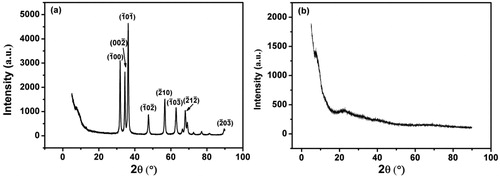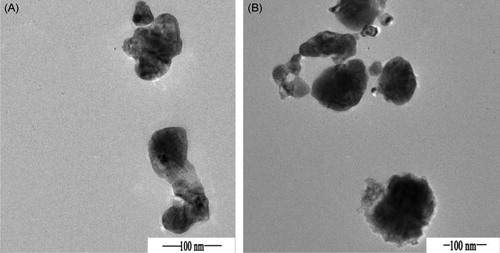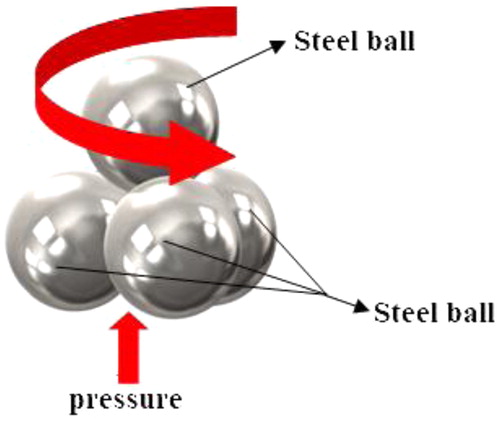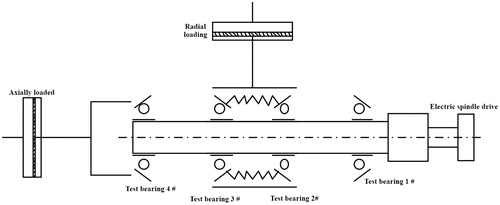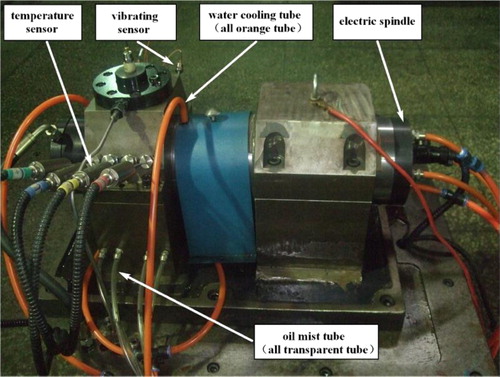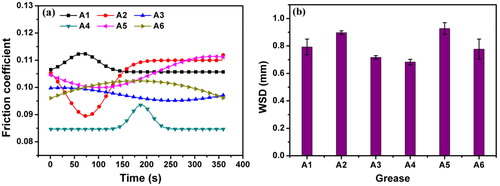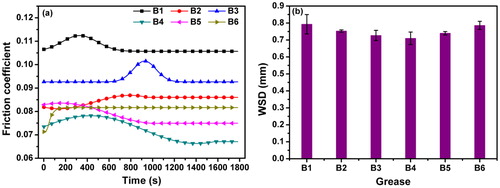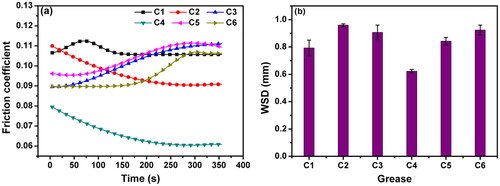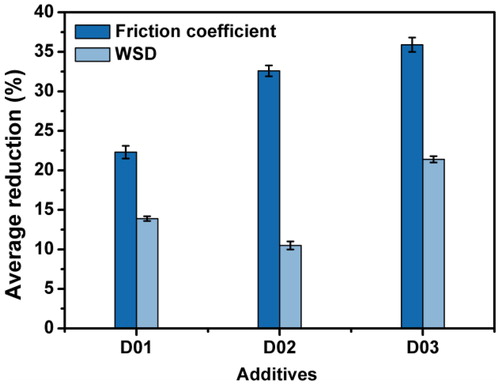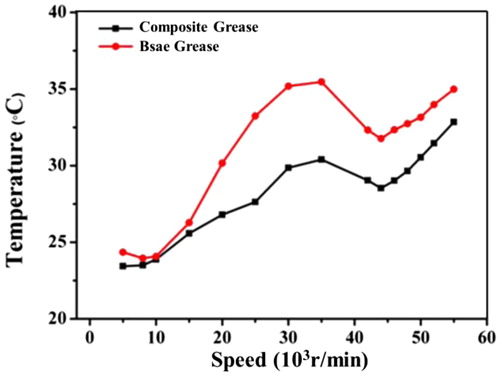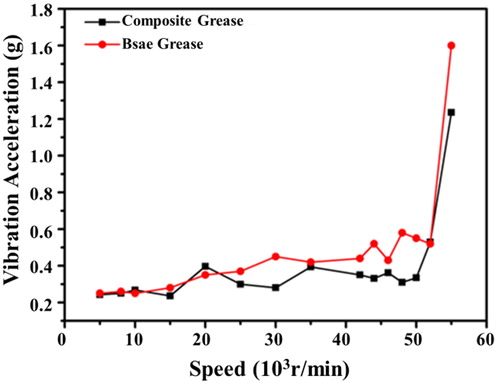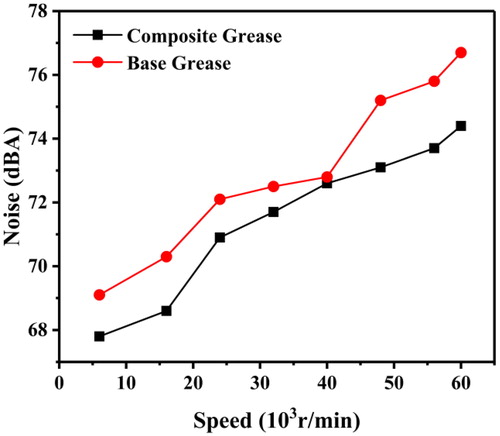 ?Mathematical formulae have been encoded as MathML and are displayed in this HTML version using MathJax in order to improve their display. Uncheck the box to turn MathJax off. This feature requires Javascript. Click on a formula to zoom.
?Mathematical formulae have been encoded as MathML and are displayed in this HTML version using MathJax in order to improve their display. Uncheck the box to turn MathJax off. This feature requires Javascript. Click on a formula to zoom.Abstract
Currently, nanoparticles have been widely used as lubricant additives, few researches have investigated their applications as additives for lubricating grease. In this paper, mixtures of ZnO and Si3N4 nanoparticles were added into grease as additives. XRD and TEM were utilized to the investigate phase composition, microstructure and morphology of the nanomaterials. The composite grease was prepared by introducing ZnO and Si3N4 nanoparticles into the grease matrix through ultrasonic dispersion. Then, tribological properties of the composite grease were measured through a MMW-1A universal friction tester. Results showed that the best lubrication performance was achieved when the composite grease contains 1 wt% ZnO and 0.5 wt%Si3N4. Under this condition, the friction coefficient and wear scar diameter decreased to 0.0701 and 0.727, which is 34.3% and 8.3% lower than that of the base greases, respectively. The morphology of composite nanoparticles is beneficial to the enhancement of antifriction property, which can be seen from SEM images. In addition, EDS analysis illuminated the accumulation of Zn and Si on the friction surface. Further researches proved its great potentials in alleviation of vibration, noise and temperature rise for high speed bearings, since the ZnO-Si3N4 nanoparticles-based composite grease showed excellent lubrication and antifriction properties.
1. Introduction
As one of major reasons for materials failure, friction and wear is attracting more attention [Citation1]. Up to now, it is still a challenge for the world to develop a tribological system that is antifriction, wear resistant and capable of self-repairing [Citation2]. Grease is an indispensable lubricant used in mechanical equipment, which can help to decrease friction and wear, as well as prolong the service life of equipment. Lithium lubricating grease, which is featured by high drop point, multiple effect and high adaptability, has been widely applied in industrial fields such as mechanical engineering, aeronautics and astronautics.
Compared with traditional additives for lubricating grease, nanomaterials are characterized by large specific area, high diffusion rate, decreased melting point and easy to sinter [Citation3]. In recent years, lots of works have been reported about the tribological behavior of lubricating greases with single nanoparticles, including metal nanoparticles such as copper, iron, cobalt [Citation4–6], metal oxide nanoparticles such as ZnO, ZrO2, TiO2, CuO [Citation7–12], metal sulfide nanoparticles [Citation13–14], as well as graphite nanoparticles and diamond nanoparticles [Citation15–16]. These studies indicate that the nanoparticle endows lubricating greases with better antifriction and antiwear properties by reducing friction coefficient and wear scar diameter, which is different to traditional load-carrying additives. Therefore, nanomaterials can be regarded as a new type of additives for lubricating grease and is expected to improve the lubrication performance. However, only a few researches have already been carried out to investigate the applications of composite nanoparticles as additives for lubricating grease, such as Al2O3-Al-MgO composite nanoparticles [Citation17], HBN-Al2O3 composite nanoparticles [Citation18], and SnO2-ZnO composite nanoparticles [Citation19]. Yang [Citation26] studied the lithium complex grease made from sulfurized isobutylene and ZDDP. The wear resistance of the additive in the lithium complex grease was evaluated by analyzing the morphology and elemental content of the steel ball wear scar. The bearing noise and vibration characteristics are investigated, when they are made from different material and lubricated with different materials. Parameters of their vibrations and acoustic noise were measured and dependencies of noise or vibration frequency of lubricating materials were found [Citation20]. One source of acoustic noise in roller bearings was numerically investigated, the viscosity of the lubricant was also examined [Citation21], developed and used to evaluate noise and vibration of bearings lubricated with various greases under different operating conditions [Citation22]. Tu analyzed the effects of bearing rotating speed, radial loads, speed, friction coefficient and skidding range angle on vibration characteristics of rolling element bearings [Citation23]. Liu research found that the system stability was mainly dependent on the modal coupling effect of system itself, and was affected by the friction coefficient and the surface roughness as well [Citation24]. Liu research found the effect of grooved brake disc on the tribological behaviors and friction induced vibration and noise characteristics [Citation25]. According to these researches, better antifriction and antiwear properties are achieved in composite nanoparticles system than single nanoparticles system, which proves the greater potential of the former one in friction performance improvement.
The vibration and noise are two base properties of bearings. In general, lower the two values are, better is the performance and precision the machine can realize. For precision machinery and high-grade electrical appliances, bearings should have even lower vibration and noise. Therefore, in order to enhance the performance of high-grade machinery and promote the development of machine industry, it is of great significance to enhance bearings’ performance by reducing vibration and noise, which calls for high performance lubricating greases with better antifriction and antiwear properties.
In this paper, the tribological behavior of lithium lubricating grease contains single ZnO or Si3N4 nanoparticles are investigated first. Thereafter, mixtures of these two nanoparticles with specific proportions are added into lithium lubricating grease, and a series of experiments are carried out to investigate properties of antifriction, antiwear and surface repairing. It is expected that the mixed nanoparticles are not only possessed of certain bearing capacities, but also equipped with good antifriction and surface repairing properties. Furthermore, applications of nanoparticles-based lubricating grease in high-speed bearings demonstrate its potentials in vibration and noise reduction.
2. Experiment method
2.1. Phase analysis of nanoparticles
ZnO nanoparticles (purity > 99.9%) was purchased from Chenguand Reasearch Institute of Chemical Industry Co. Ltd. Si3N4 nanoparticles (purity > 99.9%) was supplied by Chengdu Kelong Factory of Chemical Engineering Reagent of China. D8 Advance X-ray powder diffractormeter was utilized to conduct phase analysis on ZnO nanoparticles and Si3N4 nanoparticles. shows the XRD spectrogram of each nanoparticle. By comparing the XRD spectrogram of ZnO nanoparticles in to powder diffraction file database (PDF), this nanoparticle can be identified as ZnO with high purity. ZnO nanoparticles have characteristic diffraction peaks at 31.7°, 34.42°, 36.26°, 47.54°, 56.6°, 62.9° and 89.6°, which correspond to crystal face ,
,
,
,
,
and
of ZnO, respectively, which shows that the ZnO nanoparticles used in this work has a hexagonal structure. shows no apparent characteristic diffraction peaks, which proves the amorphous structure of Si3N4 nanoparticles.
Transmission electron microscopy (TEM) was used to observe the morphology of ZnO and Si3N4 nanoparticles and measure average particle diameter. shows the TEM images of ZnO and Si3N4 nanoparticles, both of which showed grained form and uniform size distribution. The sizes of ZnO nanoparticles and Si3N4 nanoparticles were measured to be ca. 60 nm to100 nm, respectively.
2.2. Preparation of lubricating grease
The lithium lubricating grease purchased from FAKKT CHEMICAL CO. LTD. was used in the experiment. shows its physical and chemical characteristics. The lubricating grease contained with additives was prepared as follows. Firstly, nanoparticles were added into 30 g base grease and evenly mixed. Then put it into an ultrasonic oscillator to agitate for 15 min. At last, a three-roll grinder was used to grind the mixed grease for 3 times. show the content of different nanoparticles in the experiment.
Table 1. Physical and chemical parameters of lithium grease.
Table 2. ZnO nanoparticles content.
Table 3. Si3N4 nanoparticles content.
Table 4. Mixed nanoparticles content.
Table 5. Mixed nanoparticles content.
2.3. Friction test
Four-ball wear test was carried out through a MMW-1 universal friction wear testing machine. Due to excellent hardness and wear resistance, GCr15 steel is one of the most commonly used high-carbon chromium bearing steel, due to its excellent hardness and wear resistance, which exhibits good fatigue life in rolling element bearings. shows the test principle. The diameter of GCr15 steel ball is 12.7 mm, and the hardness is 59∼61 HRC. During the test, the friction coefficient was automatically recorded by the computer connected with the tester. Conditions of friction and wear test were as follows: loading force 392 N, temperature 75 °C, rotate speed 1200 r/min, and testing time 60 min. All steel balls should be rinsed with petroleum ether in an ultrasonic cleaner for 10 min. The diameter and morphology of wear scar on steel balls were measured by optical microscope, SEM and 3D profiler. In addition, each test should be repeated for 3 times to ensure the standard deviation of each test was lower than 1%.
2.4. High speed bearing test
High speed bearing test was conducted through a T80-25NT high speed spindle tester (Luoyang Bearings Research Institute, Henan, China). shows the test principle. Angular contact ceramic ball bearing B7005C/HQ1P4 and steel ball bearing specific to high speed grinding spindles were used in this test. Firstly, the angular contact ceramic ball bearing was filled with lithium lubricating grease or nanoparticles-based composite lubricating grease. At room temperature, conditions of the bearings test were set as Fa = 160 N and Fr = 0 N. Rotating speed was gradually increased, from 5000 to 55,000 rpm, at intervals of 5000 rpm and kept for 20 min. An integrated temperature sensor JM608V-PT100 was applied to measure temperatures of inner and outer rings. The noise meter was placed in the range of 1m from the spindle to measure its vibration noise value. Meanwhile, YD-3 accelerometer was used to monitor the vibration state of bearings. The monitoring data was then integrated and processed by the connected computer and relative data processing software. shows the overall view of test machine.
3. Results and discussion
3.1. Friction properties of ZnO-contained lubricating grease
shows changes of grease friction coefficient to time as well as wear scar diameter of steel balls at different ZnO contents. As shown from the , the friction coefficient of ZnO-contained grease is obviously lower than that of the base grease, which proves the enhancement of antifriction property by ZnO nanoparticles. For the base grease (A1), the friction coefficient increases first then decreases during first 150 s of the test, after that, it tends to be stable. The friction coefficient of A2 decreases at first, then increases and stabilises at about 0.11 in the end. The friction coefficient of A3 and A6 are at a stable level of ca. 0.1 during the whole test. The friction coefficient of A4 is stabilized at about 0.085 during most of the test, except for the sudden increase at about 200 s. shows the changes of wear scar diameter, A3 and A4 have much smaller diameter compare to the base grease. demonstrates that the composite grease has the lowest friction coefficient when the content of ZnO nanoparticle reaches to 1.2%, which is 22.3% lower than that of the base grease. On the other hand, as ZnO nanoparticles increases, the wear scar diameter decreases at first and then increases, and reaches the minimum value at content of 1.2%, which is 13.9% lower than that of the base grease. Li [Citation27] in the article proposed a variety of nanoparticles as additives that can improve the base grease antiwear and antifriction performance and bearing capacity. Therefore, it can be concluded that the addition of ZnO nanoparticles is beneficial to the improvement of antifriction and antiwear properties of lithium lubricating grease.
3.2. Friction properties of Si3N4-contained lubricating grease
shows changes of grease friction coefficient to time as well as wear scar diameter of steel balls at different Si3N4 contents. As can be seen from , the friction coefficient of Si3N4-contained grease is lower than that of the base grease, which proves the enhancement of antifriction property bring by Si3N4 nanoparticles. The friction coefficient of B3 shows a sudden increase at 900s, and then reaches to stable level at about 0.093. The friction coefficient of B4 slightly increases at first, then declines sharply, at last tends to be stable. As for B5, the friction coefficient experiences continuous decrease at the beginning of the experiment, then maintains a stable level after 1000 s. Considering the wear scar diameter, the grease containing additives has a much lower value than the base grease, which demonstrates the beneficial effect of Si3N4 nanoparticles on the antiwear property of lubricating grease. As the Si3N4 nanoparticles increases, the wear scar diameter decreases first, then increases. When the content of nanoparticles increases from 0 to 0.3%, the wear scar diameter of Si3N4-contained lubricating grease declines from 0.79 mm to 0.706 mm. However, further increase of nanoparticles lead to the increment of wear scar diameter, which is caused by the increased viscosity of lubricating grease and incomplete dispersion of nanoparticles in the grease. As shown from , when the content of Si3N4 nanoparticles reaches to 0.3%, the average value of friction coefficient is 32.6% lower than that of the base grease, the wear scar diameter also achieves the minimum value, which is 10.5% lower than that of the base grease. At this condition, the composite grease has the lowest friction coefficient and wear scar diameter, which proves the excellent antifriction and antiwear properties. To sum up, both ZnO-contained grease and Si3N4-contained grease can greatly improve antifriction and antiwear properties of lithium lubricating grease. Therefore, it is supposed to further enhance the antifriction property of lithium lubricating grease by introducing mixtures of ZnO and Si3N4 nanoparticles in a certain ratio.
3.3. Friction properties of ZnO-Si3N4 nanoparticles-based composite lubricating grease
shows change in grease friction coefficient with time as well as wear scar diameter of steel balls at different ZnO-Si3N4 contents. As can be seen from , the friction coefficient of ZnO-Si3N4 nanoparticles-based grease is obviously lower than that of the base grease, which proves that the enhancement of antifriction property is brought about by composite nanoparticles. As time increases, the friction coefficient of C2 and C4 gradually decreases, while that of C3, C5 and C6 gradually increases, all of them reach a stable level in the end. As the content of nanoparticles increases, the wear scar diameter experiences an ‘increase–decrease–increase’ process. shows that when the content of ZnO is 1.0% and Si3N4 is 0.5%, the composite grease has the lowest friction coefficient and wear scar diameter, the average value of friction coefficient is 35.9% lower than that of the base grease, while the wear scar diameter decreases by 21.4%. shows the average reduction (%) of friction coefficient and wear scar diameter of lubricating greases with ZnO, Si3N4 and composite nanoparticles. Compared to lubricating greases with single nanoparticles, ZnO-Si3N4 nanoparticles-based grease shows better antifriction and antiwear property.
3.4. Wear surface analysis
shows the morphology and 3D profile of the wear scar caused by base grease and composite nanoparticles-based grease. According to , the wear scar diameter under friction of base grease ( is much larger than that of composite grease. shows the detailed view of with enlarged scale. It shows that under friction of base grease, apparent grinding cracks with large depth appeared on the surface of wear scar. On the other side, the wear scar results from friction of composite grease have uniform and relative shallow cracks. As can be seen from , under the friction of composite grease, the wear scar has smaller diameter, fewer wear extent, and more uniform grinding cracks. Therefore, when considering antifriction and antiwear property, the composite grease is superior to the base grease.
Figure 10. Wear scar morphology of (a), (c), (e) base grease and (b), (d), (f) composite nanoparticles-based grease.
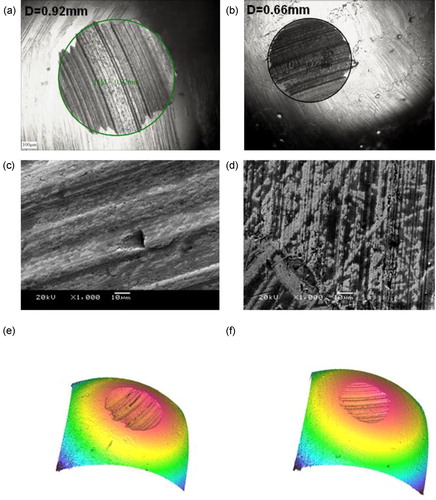
shows SEM images of the wear surface under different test conditions. After being lubricated by the base grease, the test specimen is worn for 60 min, then apparent scratches and plastic deformations are appeared on the surface of specimen, which could be found in . On the other side, after being lubricated by the composite grease with 1.0% ZnO and 0.5% Si3N4 nanoparticles and subsequently worn for 60 min, fewer scratches and plastic deformations are found, which agreed with . In addition, the wear scar also exhibits certain adhesive characteristics, which demonstrates the reparation effect of composite nanoparticles-based additives to wear surfaces.
Figure 11. (a) SEM images of wear surface by using base grease and (b) composite nanoparticles-based grease.
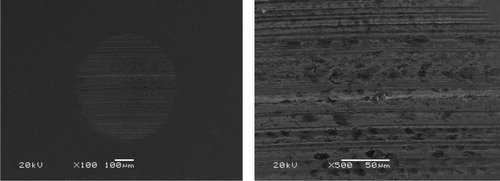
describes the element distribution on wear surface by using composite nanoparticles-based grease. Characteristic peak represents for Zn and Si can be seen clearly, which illustrates the formation of deposition films consist of Zn and Si are formed. As can be seen from and , Zn and Si are more easy to deposit on the surface, being severely worn. This may be caused by following reasons: ZnO and Si3N4 nanoparticles deposit on the wear surface first, under high temperature and high pressure. They will melt and spread on the wear surface to form a layer of thin film or combines with the wear surface to form solid solutions. During the high-pressure friction process, melted Zn and Si are more easily to accumulate on seriously worn surfaces, so that the wear surface can be repaired effectively.
Figure 12. (a) Morphology and (b) original wave crest curve of wear surface by using composite nanoparticles-based grease.
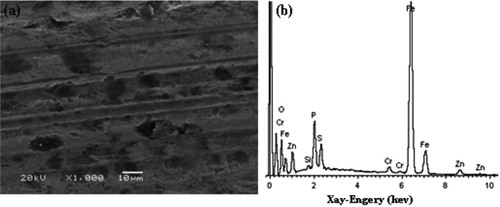
Table 6. Surface element distribution.
3.5. High speed bearing test
The high speed bearing test was conducted by adding composite grease into the test machine. Temperature changes of each bearing under different rotating speed were recorded, then the average temperature of bearing lubricated by base grease and bearing lubricated by composite grease were calculated, compared and analyzed. The base grease and composite grease contained 1 wt% ZnO and 0.5 wt% Si3N4 were used as the lubricant and added into experimental bearing, respectively. shows bearing temperature-rotating speed curve. As the rotating speed increases, bearing temperature increases first then decreases, the maximum temperature of bearing lubricated by base grease and bearing lubricated by composite grease is about 35 °C and 30 °C, respectively. This result is due to the high viscosity of lubricating grease, friction surface will encounter greater friction resistance, so the bearing temperature rises. When nano particles are added to the grease, it will reduce the viscosity of the lubricating grease, and then reduce the frictional resistance on the friction surface, at the same time, the nanoparticles are deposited on the friction surface at the beginning of the experiment, which is similar to the effect of ball bearing, and the friction coefficient between the bearing components is reduced by sliding friction into rolling. This is the reason that the bearing temperature is lower than the base grease, which causes the compound lubricating grease to lubricate. Therefore, it is demonstrated that the composite grease has outstanding cooling effect on high speed bearings.
Vibration values of each rotating speed under different lubricating conditions were obtained from the test. The vibration value of front bearing was recorded, and vibration acceleration–rotating speed curve was plotted and compared, which can be seen in . In low speed range, the vibration of bearings increases with the increment of rotating speed; while in high speed range, the rotating speed changes little. The vibration acceleration of bearings under lubricating condition of composite grease contained 1 wt% ZnO and 0.5 wt% Si3N4 nanoparticles, which is smaller than that of base grease, which shows certain cushioning effect. Therefore, comparing to the base grease, the composite grease not only exhibits excellent lubrication effects on high speed bearings, but also shows better vibration and noise reduction performance.
shows that the noise increases as the spindle speed increases. The noise levels are increased by the bearing vibration of test machine and operation of its drive motorized spindle. The noise of bearing increases as the rotating speed increases. Maximum noise of the bearing lubricated by base grease and bearing lubricated by composite grease is about 77dBA and 74 dBA, respectively. The reason for this result is that at the beginning of the experiment, nano-silicon nitride particles have high particle hardness and small size. So with the increase in rotational speed, they will be dispersed in the lubricant film, and then quickly spread to the surface of the friction pair, and then form a layer of ‘ball’-like particles of the structure layer on the contact surface, effectively preventing bearing parts contact, thereby reducing the contact area. At the same time, the presence of nano-silicon nitride particles enhances the resistance of the lubricating film to external forces, and when they begin to wear, the nanometer ZnO particles with moderate hardness will be filled into the grinding scar, thus reducing the friction coefficient and the noise. Therefore, the appropriate amount of nano-silicon nitride and nano-ZnO particles added to the lithium base grease can effectively reduce the high-speed bearing vibration and noise characteristics.
4. Conclusions
In this paper, the friction property of lithium lubricating grease with single or composite nanoparticles with different content are investigated. Besides that, relative bearing temperature tests are also carried out. Changes of friction property and wear scar diameter with the increment of nanoparticle content are analyzed, and wear surfaces are also compared. Experiment results show that the addition of nanoparticles can significantly improve antifriction and antiwear properties of the grease. When 1wt% ZnO and 0.5 wt% Si3N4 are added, the composite grease has the best lubricating performance, the friction coefficient and wear scar diameter decreases to 0.0701 and 0.727, which was 34.3% and 8.3% lower than that of base grease, respectively. Fewer scratches and plastic deformations are found on wear surfaces after the addition of composite nanoparticles. During the high pressure friction process, melted Zn and Si easily accumulate on seriously worn surfaces, so that the wear surface could be repaired effectively. Moreover, the high speed bearing test proves the great potential of as-prepared composite greases in the field of vibration and noise reduction of bearings.
Disclosure statement
No potential conflict of interest was reported by the author.
Additional information
Funding
References
- Bao-Sen Z, Bin-Shi X, Yi X, et al. CU nanoparticles effect on the tribological properties of hydrosilicatepowders as lubricant additive for steel–steel contacts. Tribol Int. 2011;44:878–886.
- Qi X, Lu L, Jia Z, et al. Comparative tribological properties of magnesium hexasilicateandserpentine powder as lubricating oil additives under High temperature. Tribol Int. 2012;49:53–57.
- Tian X, Gu C, Zhu G, et al. Study on tribological properties of the lubricating oil containing Cu and La2O3-Ce2O3 nanoparticles. Marine Technology 2010;79–82:255–258.
- Padgurskas J, Rukuiza R, Prosycevas I, et al. Tribological properties of lubricant additives of Fe, Cu and Co nanoparticles. Tribol Int. 2013;60:224–232.
- Wang XL, Yin YL, Zhang GN, et al. Study on antiwear and repairing performances about mass of nano-copper lubricating additives to 45 steel. Phys Proc. 2013;50:466–472.
- Qiang H, Anling L, Yuan S, et al. Design and application on experimental platform for high-speed bearing with grease lubrication. Adv Mech Eng. 2015;7:168781401561864.
- Hernández Battez A, González R, Viesca JL, et al. CuO, ZrO2and ZnO nanoparticles as antiwear additive in oil lubricants. Wear. 2008;265:422–428.,
- Ma S, Zheng S, Cao D, et al. Anti-wear and friction performance of ZrO2nanoparticles as lubricant additive. Particuology. 2010;8:468–472.
- Zulkifli NWM, Kalam MA, Masjuki HH, et al. Experimental analysis of tribological properties of biolubricant with nanoparticle additive. Proc Eng. 2013;68:152–157.
- Shenoy BS, Binu KG, Pai R, et al. Effect of nanoparticles additives on the performance of an externallyadjustable fluid film bearing. Tribol Int. 2012;45:38–42.
- Wu YY, Tsui WC, Liu TC. Experimental analysis of tribological properties of lubricatingoils with nanoparticle additives. Wear. 2007;262:819–825.
- Hernández Battez A, Viesca JL, González R, et al. Friction reduction properties of a CuOnanolubricant used as lubricant for a NiCrBSi coating. Wear. 2010;268:325–328.
- Yadgarov L, Petrone V, Rosentsveig R, et al. Tribological studies of rhenium doped fullerene-like mos 2, nanoparticles in boundary, mixed and elasto-hydrodynamic lubrication conditions. Wear. 2013;297:1103–1110.
- Kalin M, Kogovšek J, Remškar M. Mechanisms and improvements in the frictionand wear behaviorusing MoS2nanotubes as potential oil additives. Wear. 2012;280-281:36–45.
- Huang H, Tu J, Gan L, et al. Preparation and tribological properties of graphene nanosheets as additive in liquid paraffin. Tribology. 2005;38:1495–1500.
- Chu HY, Hsu WC, Lin JF. The anti-scuffing performance of diamond nano-particles as an oil additive. Wear. 2010;268:960–967.
- Li B, Ma C, Jiang Q. Tribological properties of mixed Al2O3-Al-MgO nanoparticle additive in lithium grease. J Dalian Jiaotong Univ. 2010;6:80.
- Abdullah MIHC, Abdollah MFB, Amiruddin H, et al. Optimization of tribological performance of hBN/AL2O3 nanoparticles as engine oil additives. Proc Eng. 2013;68:313–319.
- Dong L, Xu G, Li H, et al. Tribological properties and self-repairing effect of SnO2/ZnO nanoparticles as lube additive. Petrol Process Petrochem. 2005;12.
- Augustaitis VK, Bucinskas V. Dependency of bearing noise properties on surfaces lubrication. Mech. 2011;17:381–387.
- Rho B-H, Kim D-G, Kim K-W. Noise analysis of cylindrical roller bearings operating under zero external load. Tribol Trans. 2005;48:238–244. April/June Vol. Issue
- Ramamurthy S, Krousgrill CMS. Farshid vibration in grease lubricated bearing systems. Tribol Lubricat Technol. 2011;67:50–58.
- Wenbing T, Haibin H, Luo Y. Vibration characteristics of rolling element bearings based on rolling elements' skidding feature. J Vibrat Shock. 2017;36:166–170.
- Lu HM, Zhang LJ, Yu ZP. Effects of surface roughness on the friction-induced squeal noise. Tribology. 2011;31:473–479.
- Liu M, Wang D, Jianxi LI. et al. Characteristics of the tribological wear, vibration and squeal noise of brake disc surfaces with grooves. J Vibrat & Shock. 2018;1(23):23–28.
- Yang H, Yao L, Sun H. et al. Study on anti-wear properties for the lithium complex grease. Acta Petrol Sin. 2011;(27):71–75.
- Bao-Liang LI, Chi MA, Jiang QY. Tribological properties of mixed Al_2O_3-Al-MgO nano-particle additive in lithium grease. J Dalian Jiaotong Univ. 2010;7:102–107.

